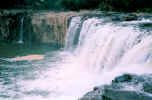When I have looked on the immigration site one of the first things I looked at was do they require my trade, being an electrician I quickly established that this is a trade that was in short supply and New Zealand is a country needing electricians.
This can be found out on the immigration site and is pretty straight forward to find out if you can be a skilled migrant and checking if an area of New Zealand has a skills shortage. One other thing I did check before I went any further was to see if I had enough points to apply for immigration, the system they use is that you have to have a certain amount of points via a questionnaire before proceeding, I passed that bit.
My thoughts of the country of New Zealand and should I take the plunge before I get too old to go to New Zealand!!
Saturday, 2 June 2007
Friday, 1 June 2007
A bit more about New Zealand

New Zealand is a country in the south-western Pacific Ocean comprising two large islands (the North Island and the South Island) and numerous smaller islands, most notably Stewart Island/Rakiura and the Chatham Islands. In Māori, New Zealand has come to be known as Aotearoa, which is usually translated into English as The Land of the Long White Cloud. The Realm of New Zealand also includes the Cook Islands and Niue, which are self-governing but in free association; Tokelau; and the Ross Dependency (New Zealand's territorial claim in Antarctica).
New Zealand is notable for its geographic isolation, being separated from Australia to the northwest by the Tasman Sea, approximately 2000 kilometres (1250 miles) across. Its closest neighbours to the north are New Caledonia, Fiji and Tonga.
The population is mostly of European descent, with the indigenous Māori being the largest minority. Non-Māori Polynesian and Asian people are also significant minorities, especially in the cities. Elizabeth II, as the Queen of New Zealand, is the Head of State and, in her absence, is represented by a non-partisan Governor-General.This is taken from Wikipedia
Thursday, 31 May 2007
History about New Zealand

It is estimated the Maori inhabited New Zealand around 800AD. Around eight hundred years later the Western world discovered New Zealand. In 1642, in a bid to locate the mysterious, rich land Australia, the Dutch Explorer, Abel Tasman caught sight of the West Coast of the South Island.
The First European to set foot on New Zealand soil was Captain James Cook of England, in 1769. He also made the first, but inaccurate map of the country.
Settlers from England started to arrive in the 1830's, and by 1840 a Treaty was signed between the crown and the chiefs of the Maori tribes. The Treaty of Waitangi handed sovereignty of New Zealand to the Crown, and is a matter of dispute even today, as the Maori translation is not quite the same as the English.
One hundred and seven years later, in 1947 New Zealand declared independence, and became its own country, after Britain did not let New Zealand troops return to defend their home against the possibility of Japanese invasion in the Second World War.
Though all New Zealanders became New Zealand citizens, until 1977 they were still British subjects. In 1983, New Zealand was declared "The Realm of New Zealand", and in 1986 the Constitution Act removed all power from the United Kingdom to legislate for New Zealand when it was requested.
Today, Queen Elizabeth holds the title of Queen of New Zealand, and is represented by the Honourable Anand Satyanand, our Governor General. New Zealand remains part of the Commonwealth, but as an independent country.
from www.NZ.Com
Subscribe to:
Comments (Atom)
